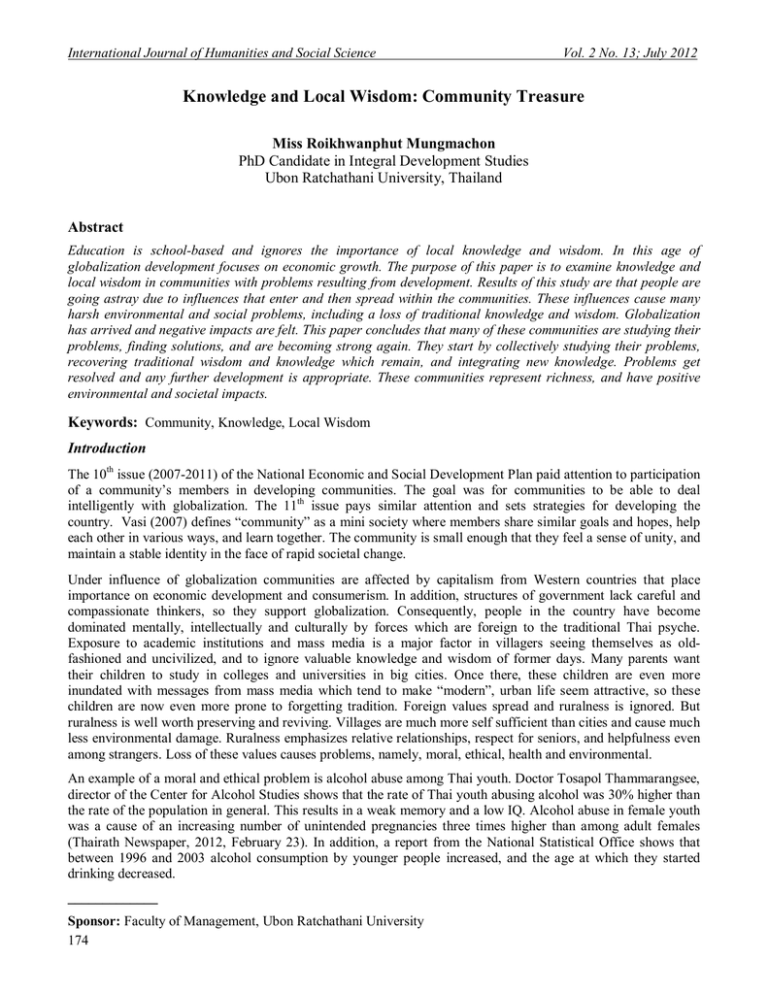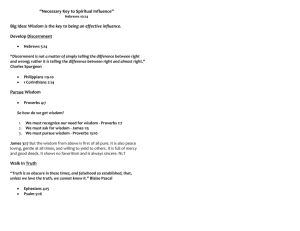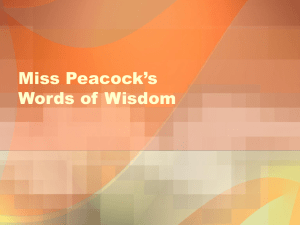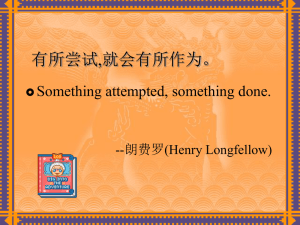Document 10464479
advertisement

International Journal of Humanities and Social Science Vol. 2 No. 13; July 2012 Knowledge and Local Wisdom: Community Treasure Miss Roikhwanphut Mungmachon PhD Candidate in Integral Development Studies Ubon Ratchathani University, Thailand Abstract Education is school-based and ignores the importance of local knowledge and wisdom. In this age of globalization development focuses on economic growth. The purpose of this paper is to examine knowledge and local wisdom in communities with problems resulting from development. Results of this study are that people are going astray due to influences that enter and then spread within the communities. These influences cause many harsh environmental and social problems, including a loss of traditional knowledge and wisdom. Globalization has arrived and negative impacts are felt. This paper concludes that many of these communities are studying their problems, finding solutions, and are becoming strong again. They start by collectively studying their problems, recovering traditional wisdom and knowledge which remain, and integrating new knowledge. Problems get resolved and any further development is appropriate. These communities represent richness, and have positive environmental and societal impacts. Keywords: Community, Knowledge, Local Wisdom Introduction The 10th issue (2007-2011) of the National Economic and Social Development Plan paid attention to participation of a community’s members in developing communities. The goal was for communities to be able to deal intelligently with globalization. The 11th issue pays similar attention and sets strategies for developing the country. Vasi (2007) defines “community” as a mini society where members share similar goals and hopes, help each other in various ways, and learn together. The community is small enough that they feel a sense of unity, and maintain a stable identity in the face of rapid societal change. Under influence of globalization communities are affected by capitalism from Western countries that place importance on economic development and consumerism. In addition, structures of government lack careful and compassionate thinkers, so they support globalization. Consequently, people in the country have become dominated mentally, intellectually and culturally by forces which are foreign to the traditional Thai psyche. Exposure to academic institutions and mass media is a major factor in villagers seeing themselves as oldfashioned and uncivilized, and to ignore valuable knowledge and wisdom of former days. Many parents want their children to study in colleges and universities in big cities. Once there, these children are even more inundated with messages from mass media which tend to make “modern”, urban life seem attractive, so these children are now even more prone to forgetting tradition. Foreign values spread and ruralness is ignored. But ruralness is well worth preserving and reviving. Villages are much more self sufficient than cities and cause much less environmental damage. Ruralness emphasizes relative relationships, respect for seniors, and helpfulness even among strangers. Loss of these values causes problems, namely, moral, ethical, health and environmental. An example of a moral and ethical problem is alcohol abuse among Thai youth. Doctor Tosapol Thammarangsee, director of the Center for Alcohol Studies shows that the rate of Thai youth abusing alcohol was 30% higher than the rate of the population in general. This results in a weak memory and a low IQ. Alcohol abuse in female youth was a cause of an increasing number of unintended pregnancies three times higher than among adult females (Thairath Newspaper, 2012, February 23). In addition, a report from the National Statistical Office shows that between 1996 and 2003 alcohol consumption by younger people increased, and the age at which they started drinking decreased. _____________ Sponsor: Faculty of Management, Ubon Ratchathani University 174 © Centre for Promoting Ideas, USA www.ijhssnet.com Research on the effect of alcohol abuse in Lopburi Province indicates that 45.6% of males with regular drinking behavior experience violent conflict, 32.9% have health problems, and 30.1% have had auto accidents (Department of Mental Health, Ministry of Public Health, 2012). Suwit Konsomboon, Deputy Minister of the Ministry of Public Health, released statistics of Thai citizens with liver and gall bladder cancer. Northeast Thailand has the highest rate in the world, with 3% to 4% or the population suffering from these cancers. This is a critical problem and is a result of alcohol abuse (Thairath Newspaper, 2012, February 23). The problems are connected and affect one another in ways which are very complicated to understand and to become aware of. Deeply rooted knowledge and local wisdom support communities well and offer feasible solutions for development. One possibility is to restore and adapt traditional wisdom to current situations, consult with wise local elders who can see through capitalism, and encourage group participation to implement solutions. 1. What are Traditional Communities? Description of Traditional Communities Boonpanya (2006) the senior developer of the Assembly of Isaan Private Development Organization, describes the history and evolution of local community. The community has its own culture, is a miniature society with a production system, resource management, a health system, a knowledge and learning system, a judicial system, self-governance, and an economic system run by each family and the community. The goals of local community are that families can be self-sufficient and the community can survive. Family members are the main source of labor. They mostly produce for their own families’ consumption, but when they sell something, the profits are very small. The people in the community live together by giving and helping without expecting anything in return. They all consider themselves to be related to every other person in the community. They share what they have with neighbors thus ensuring the survival of the families and the community. The members of the community are all related and give utmost respect to elders. This makes them “one family” living with unconditional kindness and generosity. When conflicts arise, the elders and various relatives are the ones who decide how to settle matters. A traditional community emphasizes farming. They generally produce only a little more than what they need for each household, and when there is surplus, they trade it or use it for religious purposes. The people live in balance with nature, not as masters of nature. The people respect and value each other according to the principle that each person has value as a human being. In general, communities before globalization lived harmoniously with nature. They had religion as a spiritual restraint, and respected elders. The people in the community valued one another over money and lived peacefully. In contrast, only since the mid 1950’s have communities changed as a result of the newly introduced capitalism, and more recently, globalization. 2. Change from Communities with Traditions Intact to Communities with Severe Difficulties Communities with sustainable natural resource management are led to exploit their land and produce with high technology machines that damage natural resources. Living a simple, modest life is now viewed by many people as backwards and living in poverty. Thai communities follow richer countries in their development models. Natural resources are devastated and traditional wisdom and values are destroyed (Chusakun, 2009, September 15). Thailand is affected by globalization which causes a lot of problems. It is increasingly necessary for communities to rely on local knowledge. Traditional communities are holistic learning units where direct learning and teaching is simply the natural way of life. Passing on knowledge in this way necessarily operates at every level of every activity – individual, family, community, community networks, and even the whole nation – because problems arise and spread through every level. Change happens when individuals start with themselves and then gather people together to learn about communal problems and find solutions (Wijarn, 2006). Weak communities that become strong begin with self-learning. The members must see the causes of their problems. It is unlikely that even smart, skilled, caring and conscientious development experts and government officials can solve communities’ problems. They are outsiders, and it is difficult for outsiders to understand the problems better than the community’s members themselves. 175 International Journal of Humanities and Social Science Vol. 2 No. 13; July 2012 Trying to solve problems through government giving money to individual community members as well as communities as a whole does not solve problems. Instead, it creates other problems. The members often become more indebted, or when the budget for a project is gone, the project usually comes to an end. Community members who know their problems well have a much better grasp of the situation. They can have more influence among members and are in a better position to make appropriate decisions (Salao and Jantarakeeree, 2001). One major problem is people’s inability to see through capitalism, in which powerful people take advantage of consumers in every way. It is necessary for people to realize what causes problems and find ways to free themselves from capitalistic domination. 3. Knowledge and Local Wisdom Community knowledge is transmitted through tradition (Settaboonsang, 2006). Community knowledge is obtained from both within and outside the community. It is used in ways that benefit the community and in ways which it can be passed on. The Thailand Research Fund categorizes community knowledge into three classes. (1) Knowledge to maintain the community is its history, important stories, main values, culture, traditions, regulations, and the important teachings of the community. This knowledge is an indicator of the community’s strength in the face of the flow of changing values. (2) Knowledge for a living is the knowledge of occupations, religion, and training for development of the potential quality and health of the members. (3) Knowledge of establishing harmony is the knowledge which comes from people’s enjoyment of life or the general knowledge found in coffee shops, retail shops, or meeting places such as temple halls and school sport fields. This knowledge includes storytelling, lullabies, harvest songs, everyday stories and general news. It establishes harmony through close relationships, enjoyment and strength among the members. They value elders who have knowledge that comes from life experiences (Thailand Research Fund, 2009, February 15). 3.1 Local wisdom is basic knowledge gained from living in balance with nature. It is related to culture in the community which is accumulated and passed on. This wisdom can be both abstract and concrete, but the important characteristics are that it comes from experiences or truth gained from life. The wisdom from real experiences integrates the body, the spirit and the environment. It emphasizes respect for elders and their life experiences. Moreover, it values morals more than material things (Nakorntap et. al., 1996). 3.2 Identity of Isaan (Northeastern) Local Wisdom. Each region has its own identity and local wisdom as well as universal wisdom held in common. Isaan local wisdom or the wisdom of the people of northeastern Thailand constitutes a simple way of living and benefits people in every status. The prominent characteristic is a strong connection among extended family members. They put great value on the interaction between family and community. People feel secure and happy. Importance is placed on the attainment of inner satisfaction. The people gather together to perform work which cannot be accomplished by an individual acting alone. Work such as building a house, a temple, a road, or dredging canals is done in a group which represents the essence of helpfulness and harmony (Isaan Gate, 2012, April 17). Na Thalang (2001), is an adjunct professor and the chairman of the Wisdom Foundation. He gives examples of the use of local wisdom adapted to the new society and economy now being created and developed by the people of this part of the country. (1) Isaan people traditionally maintain close contact with relatives. This helps counterbalance money issues. People traditionally share what they have with neighbors, resulting in less need of banks and other sources of money. Morality and generosity are fundamental characteristics that maintain the stability of the people. (2) From the painful lessons of industrial agriculture, many have come to embrace subsistence farming. This includes growing rice, fruits, vegetables, and raising animals for their own consumption, and to share with others in the community. Planting a variety of crops together is sometimes called Integrated Farming and is a manifestation of their traditional wisdom. (3) Many Isaan leaders have enough influence within their communities to help others resist outside forces. They encourage the ideal of “Hedkin, Hedyoo” (living simply, and being self reliant) through the use of traditional ways of Integrated Farming and thereby increase the number of self-sufficient farmers. Moreover, this has given birth to an agricultural network based on local traditions. The network is evolving to conform to new situations and contexts. Many leaders have the wisdom, knowledge and ability to influence methods of production and consumption in accord with traditions. 176 © Centre for Promoting Ideas, USA www.ijhssnet.com In summary, Isaan people use their wisdom and accumulate knowledge as is reflected in numerous local proverbs that put value on working smartly and wisely. One important value is to have knowledge and to use it wisely. For example, when there is a job too big or too difficult for one person, the people will get together and find a solution. Presently, people who have become self-sufficient have done so by using traditional local wisdom. Communities which are considered strong get their strength from members who have learned their lessons and have come to see the value of applying local knowledge and wisdom. These are important tools to help individuals and communities survive and thrive in this age of complex problems. 3.3 Local Wisdom and Recent Situations in Globalization. Maybe the biggest problem humans face these days is the inability to live harmoniously together. This ability can come from using local wisdom. People living in modern cities should learn the old local wisdom and adapt it to their circumstances (Na Thalang, 2001). The problems posed by globalization provoke many people to search for ways to better manage their lives. These ways differ depending on the choices that individuals make. Wise and knowledgeable elders were indispensible for this research, making it possible to choose an appropriate framework for communities to learn to live responsibly and sensibly. 3.4 Obstacles to Transmission of Local Wisdom Local wisdom and knowledge in communities will of course never vanish completely. Some things are however ignored, while some things are neglected, and it is these may soon be forgotten. The following are examples. Durian Plantation. The wisdom of durian culture at a plantation in Nonthaburi Province has been passed on from elders to only a few descendants. Yet the majority of this has recorded in research papers. Researchers visit the elders to conduct interviews regarding issues that interested researchers. The elders have worked with local officials to set up a center for the preservation of local wisdom of durian farming. But no educational materials have ever been written for systematic self-learning. The knowledge and wisdom that the elders have accumulated remains mostly with them, and will vanish along with them (Uporanai, 2006). Pottery. When capitalism appeared in this village in Uttaradit Province people started to refuse the traditional wisdom. Although the elders have tried to pass their wisdom on to descendants, most of the young generation have not been receptive. They say it is dirty work and that potters have a hard time making a living. The wisdom of pottery making which has been passed on for centuries may come to the end with the passing of the seniors’ generation (Kettet, 2007). Salt Boiling. Many communities in Isaan once produced salt using the knowledge of their ancestors. The locals produced salt with a small investment and the people doing the work were mainly family members. Younger people say the work is too hard for so little money. So, at present it seems that only one village in Isann still produces salt in the traditional way (Kettet, 2007). Natural Dyes. Natural dyes for dyeing cloth is found in forests. Bark, leaves, heartwood, fruit and fruit rinds can all be used for dyeing. However, because of complicated procedures, lack of natural materials and easy availability of chemicals, we notice a sharp reduction in the use of natural colors even though they have a high quality. The natural resources required to make the dyes have been depleted due to the destruction of nature. Science and technology have dramatically changed the more nature-based ways of living. The disappearance of natural dyeing traditions in the country is a real possibility (Kettet, 2007). We now face the problem of how to pass traditional wisdom on to the next generation. Loss of wisdom can happen because of the causes mentioned above e.g., there is no written record, young people do not appreciate it, the materials are lacking, the procedures are complicated, or industrial products take over. The question is, how to maintain and revive rapidly disappearing local wisdom, especially the wisdom of Isaan, which is the treasure of its people. Besides the knowledge and local wisdom which should be preserved, there also exists misunderstandings and misguided beliefs. People believe in these things so it is likely that they will become more widespread in the future. The beliefs in ghosts, mysticism and fortunetelling are wide spread among people of every age, even among the leaders of the country, and are propagated through media such as television, the Internet, radio, and books, magazines and newspapers. These beliefs are barriers to seeing the real causes of people’s problems. These beliefs are damaging to individuals, families, communities, societies, and even the country. 177 International Journal of Humanities and Social Science Vol. 2 No. 13; July 2012 Knowledge and wisdom come from study and practice. Belief in the promises propagated through media is another false belief. People living in community can more easily follow wise and moral leaders who are not infatuated with capitalism and can see through it. 4. Knowledge Management in Local Communities 4.1 Learning for Life Development has long emphasized increased income and readymade ideas to develop communities along Western models. These models do not give attention to local cultures so development has conflicted with their familiar ways of life. But each community all over the nation already has its own local wisdom and so when communities come together to combine their wisdom, they create economic capital and establish self-sufficiency from the family level upward (Thongthiaw, 2003). Learning starts with information that we get from various sources and consists of an explanation of phenomena that brings about understanding. Learning also consists of the knowledge obtained from careful thinking so that the learners can have their own vision and construct their own world view. Therefore, learning happens by accumulating information and assembling it to create knowledge (Thongthiaw, 2003). Team learning in contrast considers everyone as a teacher, and every place as a classroom. The important concept in team learning is for no one to consider their own self, their knowledge, ability and status as better or higher than those of others (Makhasiranon, 1999). There are four important features of learning in Isaan communities: independence of thought, access to nature, integration, and morality. It is necessary to have some amount of freedom in one’s thinking so as to really grasp an idea. Blindly following someone else’s instructions will not lead to understanding. Because nature is so central to traditional ways, access to forests and other natural areas is crucial. That is where materials come from for making absolutely everything, and models for understanding the social world. Being cut off from nature is the death of local traditions. Learning is a process integrating various “school subjects” such as math and science. Though these “subjects” are not named as such in traditional learning, they are inherent in the process. In deciding how much compost to use on fields, math is necessary. In understanding relationships among living things on the farm, biology and ecology are necessary. Lastly, the heart has to be wholesome in order for this wisdom to be sustainable and benefit the larger community. A person with vengeful or harmful intentions can surely learn things just as well as anyone, but for the local knowledge and wisdom to be maintained and useful to others, one’s mind must be clean and honest (Seeariya, 2009). 4.2 Community Self-sufficiency The occupation of the majority of Thais is in some form of agriculture. They use the land in their community for making a living as their ancestors did in the past. They work the land in their community for many years or for their entire lives, and live harmoniously within this context and environment. Their learning processes are systematic in a natural way. Their knowledge is passed on and modified to meet their needs from day to day. At present, there is an increasingly large gap between rural and urban societies in terms of education. This gap exists because so many people value knowledge from international schools and institutions of higher learning similar to those of Western countries. This education takes years to complete and is economically out of the reach of most rural Thais. When we compare local knowledge with institutional knowledge, local knowledge is more concrete and can be demonstrated. For example, traditional ways of forest conservation show that locals know how to take care of and manage the forest, and that they can benefit from proper management. Past efforts at development can be seen as failures for the following reasons. (1) Development experts guided, explained and solved the problems for the community without realizing that academic knowledge is not enough to truly solve community problems. (2) Government policies are often the causes of poverty and create barriers to development. For example, industrial agriculture encouraged by the government has often led farmers into debt. Inability of farmers to control prices due to the power of middlemen has caused many farmers to lose their assets. (3) Greedy corruption leads to neglect of morality and ethics. (4) Government officials have routinely taken the authority to solve the problems of communities without clear understanding of how locals think and live. These are essential to lasting solutions. Development and problem solving methods should follow the locals’ ways of life and should be implemented by locals. The process could go something like this. The locals see the problems, think them though, analyze possible solutions then choose what to apply. Implementing solutions require that people learn together and interact with each other. The participation of everyone concerned is essential in order to meet shared goals (Salao and Jantarakeeree, 2001). 178 © Centre for Promoting Ideas, USA www.ijhssnet.com Besides globalization, there is localization, and to a lesser extent, formation of new communities. Localization happens when the people in a community restore and revive the traditional ways. In this study, two examples of each are presented. Donmoo Village and Tamyae Village are examples of localization while Ratchathani Asoke and Sufficiency Economy Practice Community are examples of new communities. 4.3 Examples of Knowledge Management at the Community Level Below are five examples of communities becoming strong and stable again. The first three are in Isaan, the second is in the northern region, and fourth is in the central region. The Khaendong Network of Communities. Khaendong is a sub-district in Buriram Province. These communities have learned to become strong and stable by learning to economize their resources. The members are now confident, able to revive traditional ways of relating to one another, and cooperate in many economic activities such as making processed foods, producing herbal medicines and other health products. There is a welfare fund, support for children and youth, a marketing demonstration center, and a community savings group run by its own members (Salao and Jantarakeeree, 2001). Lahokkrasang Village in Buriram Province is one of 15 communities surrounding Kaokok forest. Between 1992 and 2002, the forest was damaged by capitalists, locals and government officials. This resulted in the poor condition of the forest with a decreased number of trees and animals. However, the problem was solved by (1) arranging a reconciliation stage to find a peaceful compromise among concerned parties; (2) entrusting the care of sections of the forest to individual communities adjoining those sections; (3) promoting a “forest at home” project by encouraging every family to have their own kitchen garden, thereby decreasing intrusion into the forest. Simply by going into the forest less often, helps the forest to regenerate on its own. (4) initiating a “talking forest” project by making signs encouraging people to take care of the forest; (5) surveying the forest with the Youths Love Nature group together with local elders who know the tree and herb species of the forest (Lertwijitjarat and Chukortuat, 2006). Saengjan Village Learning Center in Buriram Province demonstrates good knowledge management. On less than half an acre, a local philosopher and leader of the learning center brought others in the community together to help establish it. There are 40 members looking for ways the community can become more self-sufficient. They arrange an exchange of knowledge every week and visit the members’ garden beds every month to encourage learning at the community level, to become aware of knowledge and wisdom within themselves, and to learn new things from outside the community (Lertwijitjarat and Chukortuat, 2006). Pangmapha Community in Mae Hongson Province refuses to use chemical inputs in their agriculture. They also promote natural pig farming, fire prevention barriers, water channel systems, reforestation, restoration of local culture, and, traditional games in cooperation with schools. Additionally, elders are called upon to share knowledge and wisdom with youth (Lertwijitjarat and Chukortuat, 2006). Sustainable rice farming is one area of interest of the Khwan Khao Foudation in Supan Buri Province. They offer support and encourage farmers to learn sustainable methods and simple technologies. Their Farmer School offers training in biological pest control, nourishing the soil, and developing varieties of rice. The members combine their traditional knowledge with modern knowledge. This makes the community able to relate to modern knowledge and exchange knowledge among its members. The Farmer School is effective in providing farmers with practical and direct experience that is shared among members (Lertwijitjarat and Chukortuat, 2006). The results of this study show that there are five factors for successful communities. (1) Locals must be continually involved. (2) There must be a shared learning in ways that help people to understand the problems and look for solutions based on local knowledge and wisdom. (3) Study and practice must be guided by leaders in such a way as to integrate different ideas and drive them in the same direction. (4) There must be both spiritual and material development with equal attention paid to each. (5) The members must be satisfied with the results (Singrueang, 2008; Sangsee, 2008; Asoktrakul, 2006; and Faculty of Management Science, Ubon Ratcathani University & Sufficiency Economy Practice Community, Ubon Ratchathani University, 2008). 179 International Journal of Humanities and Social Science Vol. 2 No. 13; July 2012 Diagram 1 Trajectory of Community Changes Since Before the Age of Globalization 1. Traditional Communities Local wisdom and local knowledge Production mainly for one’s own family’s consumption. Nature-based ways of life. Extended families and respect for elders are the norm. Kindness, helpfulness and generosity Agriculture is the main occupation. Morality is more important than material things. 2. Communities in the Age of Globalization Emphasize Economic Development Produce for profit. Money oriented ways of life. Technology is important. Farming is sophisticated. Capitalism takes advantage of people, and is a major cause of natural resources destruction. Ways of life are out of balance and people become estranged from the natural world. Communities rely on help from development experts and government officials. People value Western style education and largely neglect traditional knowledge and wisdom. 3. Learning Communities Examples of restoration - Kheandong Network of Communities, Buriram Province; Lakokkrasang Village, Buriram Province; Seangjan Village Learning Center, Buriram Province; Pangmapha Community, Mae Hongson Province; Sustainable Agricultural Rice Farming by Khwankhao Foundation, Supanburi Province Locals initiate solutions to problems stemming from inappropriate development. 4. Fulfillment of the 11th Issue of the National Economic and Social Development Plan (2011-2016) Salao and Jantarakheeree (2001) from the Faculty of Humanities and Social Science, Nakhorn Sawan Ratjabhat Institue, assert that many successful communities learn that success is not a matter of having a large number of members, having unlimited resources or sophisticated knowledge. Successful communities realize that they must manage their capital, manage natural resources, and govern well. Sustainable development starts with the existing situation and advances in small steps until the community is finally strong and self-sufficient, and able to depend on itself. Problem solving and development of the community should rely on local harmony gained through the process of learning together as a community. Activities by the whole community will eventually bring forth results, which are crucial in order for members to willingly cooperate at each step. The members share responsibilities and all are conscious of being collective owners of the community. Eventually, they become accustomed to a democratic way of living, which is the most important value at the root of all other values. Conclusion This study concludes that traditional Thai communities have sufficient knowledge to depend on their own selves with their own ways of living which in turn depend on nature. The main occupation of the community is agriculture. Members live intimately, helping each other and sharing what they have. This sort of life has enormous value for people and so ought to be revived and maintained to the extent possible, while incorporating new ideas and new ways that do not destroy the very fabric of traditions. 180 © Centre for Promoting Ideas, USA www.ijhssnet.com The spark that lit the fire forcing communities to change is globalization, in which powerful people take advantage at every turn. This has influenced people’s basic ways of subsistence. Instead of producing mainly for family consumption, people invest money so that they can make something to sell for a profit, and accumulate savings. This concept started to become widespread in Thailand only in the last forty or fifty years. Simple small scale farming has turned into sophisticated agriculture for economic gain. Forests are devastated to make more room for this way of agriculture. Chemical fertilizers and pesticides are used to produce large harvests that negatively affect the environment. A way of life centered on being human has turned into a way of life placing more value on money and material things. Many communities turn such a crisis into an opportunity through seeing the problems and possibilities then collectively setting goals. Together they understand, discuss, and look for solutions to their problems, with elders being an important part of this process. They revive what traditional knowledge and wisdom remain, adapt them to the goals that they have set, and little by little make real improvements to individual, family, and community life. People learn to better manage and understand their lives. Community development is not about money, nor help from the government, and not about waiting for suggestions from experts and government officials to provide the magic key to unlock the door to progress. Selfsufficiency must come from within the community and from within its own traditions. References Asoktrakul, R. (2006). The Practice of Virtue in Ratchathani Asoke Community, Ubon Ratchathani: Social Innovation from the Wisdom of Buddhism. Research supported by funds from the Office of National Culture. Ministry of Culture. Boonpanya, B. (2006). Concepts of Local Culture. Bangkok: Duean Tula Printing. Chusakul, S. (2009). “The Role of a Private Development Organization in Managing Community Knowledge: A Lesson from Isaan” in We Build Opportunity Together in Social Development: http://us.thaingo.org/webboard/view.php?id=1580 (September 15, 2009) Department of Mental Health. Ministry of Public Health, (2012). Alcohol Consumption Behavior: http://praewzoetic.blogspot.com/2010/02/blog-post. 28.html (February 24, 2012) Faculty of Management Science & Sufficiency Economy Practice Community, Ubon Ratcathani University. Research Report on the Administration System of the Sufficiency Economy Practice Community of Ubon Ratchathani University: Community Administration and Education and Training Service. Independent Study, Faculty of Management, Ubon Ratcathani University. Ubon Ratcathani. Thailand. Isaan Gate. (2010). What Is Wisdom?. http://www.isangate.com/local/Knowledge. Html (April 17, 2012) Kettet, B. (2007). Wisdom of Nature Builds Value, Local Wisdom Sustains People. Lertwijitjarat, W & Chukortuat, O. (2006). Varieties of Knowledge Management. Bangkok: Beam Advertising. Makhasiranon, W. 1999. The Management of Local Wisdom. Bangkok: Expertnet. Na Thalang, E. (2001). Isaan Wisdom. Bangkok: Amarin Printing and Publishing. NakhornThap, S. (1996). Report of the Study on Patterns of Process in Promoting Teacher and School Participation for Prevention and Solution of Problems Concerning Child Labor in Thailand. Journal of Research on Humanities Information Study. Office of the National Education Commission. Salao, S. & Jantarakeeree, R. (2001). Learning Processes of People. Bangkok: Sawan Witee Printing. Setboonsang, S. (2006). Seven Steps to Sufficiency Economy. Bangkok: Witeesuk Foundation. Singrueang, P. (2008). A Strong Community: A Case Study of Baan Donmoo, Tambol Khampia, Trakanpuetpol District, Ubon Ratchathani Province. Unpublished Master’s thesis, Ubon Ratchathani University, Ubon Ratchathani, Thailand. Sungsee, A. (2008). Factors Affecting a Community Fund when Establishing a Financial Institution in Baan Tamyae Community, Moo 11, Tambol Muangsamsip, Muangsamsip District, Ubon Ratchathani. Unpublished Master’s thesis, Ubon Ratchathani University, Ubon Ratchathani, Thailand. Bangkok: ANT Office. Thailand Research Fund. (2009). Characteristics and Types of Community Knowledge. http://www.trf.or.th/News/Content.asp?Art_ID=184 (February 15, 2009) Thairath Newspaper, (2012), Thai problems. http://www.thairath.co.th/ (February 23, 2012) Thongthiaw, T. (2003). Learning for Work Planning and Networking to Strengthen the Community. Bangkok: King Mongkut’s University of Technology. Uparamai, P. (2006). Learning The Process of Imparting Thai Local Wisdom in Informal Education in Nonthaburi: Durian Plantation. Sukhothai Thammathirat Journal. 19, (1): 71-78. Vasi, P. (2007). Human Ways in the 21st Century. Bangkok: Plan Print. Wijarn, B. (2006). Knowledge Management to…Intellectual Practice. Bangkok: Thankol Printing. Seeariya, Y. (2008). The Tao of Social Science Recovers the Roots of Western Culture Using the Theory of the World System and the Tao of Physics. Bangkok: Pimdee. 181




